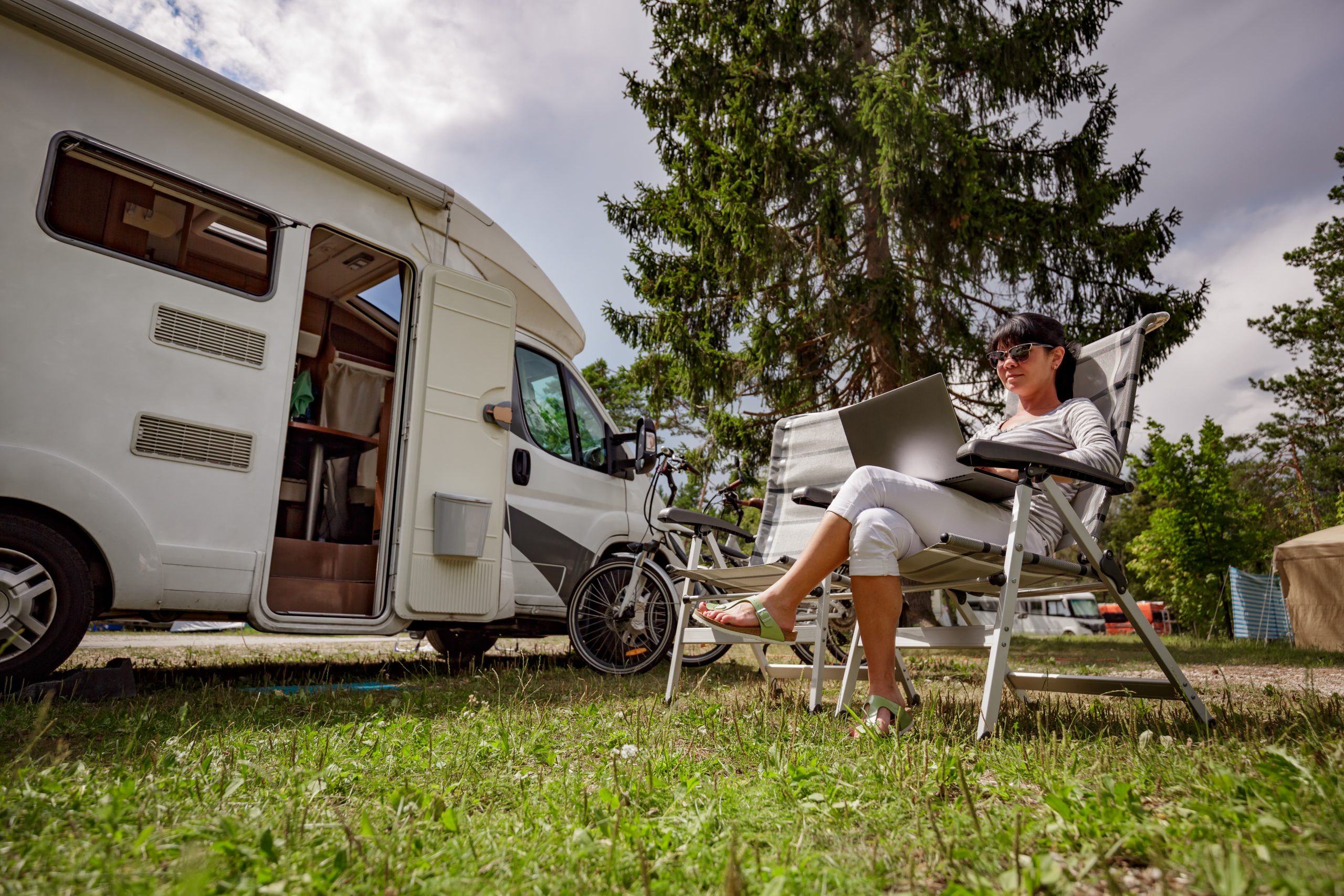
Here’s How RVers Can Get Starlink Satellite Internet
Unless you have been living in the middle of nowhere with no internet since 2015, you have heard of SpaceX and Starlink satellite internet. Come to think of it, you may be living in an RV off the grid, so that’s entirely possible. If that’s the case, since you are reading this article, I’d like to be the first to welcome you back to the land of internet connections. I’ll fill you in on what you’ve missed.
Elon Musk’s SpaceX has been cheaply sending hundreds of small satellites into orbit with its reusable rockets. The purpose is to create a global internet service that will bring internet connectivity to the most remote places on Earth and thousands of users in not-so-remote places. The project started in 2015 and was given the name Starlink in 2017. If the company meets its goals, they will have thousands of satellites in orbit in the coming years.
It should be noted that launching thousands of satellites into low earth orbit does carry some potential problems. The satellites can obstruct the view of astronomers detecting things like asteroids. There is also the issue of space debris being a problem. Both are genuine issues, and SpaceX has been working with astronomers and NASA to find ways to make its satellites less visible and automatically deorbit the satellites at the end of their life.
The countermeasures aren’t yet perfect. However, SpaceX isn’t the only company planning on launching hundreds of satellites. At some point, we will have to figure out how to deal with the problem as a planet. If SpaceX can come up with some good ideas while it builds its network, other companies could use similar methods.
Starlink Satellite VS Traditional Satellite
The traditional satellite internet that is available for RVers at this moment in time is slow and expensive. It currently costs about $400 a month for a 2Mbps connection and a latency of over 500ms. If that sentence sounded like Greek to you, check out this Starlink article. It explains latency, speed, and why traditional satellite internet is so slow.
Here is a quote from that article explaining some of the ways Starlink satellite internet plans to solve some of the problems that traditional satellites 23,000 miles above Earth have.
“Since Starlink internet satellites are only about 340 miles above the Earth, they have much lower latency. In addition to being closer, each satellite is equipped with lasers to send information to neighboring Starlink satellites, resulting in quicker response times. As more Starlink satellites are brought online, it will only improve.”
Starlink satellite internet is a high-speed satellite internet service with current speeds reaching over 150Mbps and a latency that aligns with DSL internet. You can set up the whole kit at home, and the hardware costs $499 with a $99 a month subscription.
This internet type does not rely on cell tower location, RV park WiFi, or cable lines. As long as there is a clear view of the sky, you can have high-speed internet. In theory, you could use it just like RVers use satellite TV. Set it out, plug it in, and boom, internet. Unfortunately, Starlink satellite internet isn’t ready to be taken across the country in your RV just yet, but we are closer than ever.
Starlink For RVs is Coming
SpaceX recently filed with the FCC to get approved to make what it calls Earth Stations in Motion or ESIM. ESIMs are a version of the current satellite hardware that can be mounted on moving vehicles like trucks, planes, boats, and RVs.
If you are like me, you had several questions when you read this news. When will it be available? How much does this new mounted Starlink satellite internet device differ from the current hardware? Can I install it myself? Does it have to be mounted, or can I use the traditional hardware and set it up wherever I go?
Those are all excellent questions, and we can use Starlink’s website and its FCC filing to answer some of them. Unfortunately, we are going to have to do some speculating too. Let’s dive into the world of technical FCC filing and find out when you can get your futuristic internet connection attached to your RV.
When will it be available?
The short answer is no one knows yet. We know from some answers on a Reddit AMA thread that Starlink satellite has been working on the issue of making its internet service mobile for a while.
The team said, “Mobility options – including moving your Starlink to different service addresses (or places that don’t even have addresses!) – is coming once we can increase our coverage by launching more satellites & rolling out new software.” You can check out some other questions that RVers might be interested in here.
So the only thing restricting Starlink satellite internet from being mobile is the number of satellites available and the software setup. For those that already have Starlink, making it movable may be as easy as a firmware or software update, which could be coming soon. Getting one mounted to your RV may be a while yet. Still, it’s entirely possible to see developed units being tested before the end of the year.
Can I install it myself?
The user can install the current residential hardware in a relatively short amount of time. Everything you need comes packed in one box. Below is a video of one customer setting up their Starlink satellite system.
As you can see, the setup is almost as simple as placing the satellite and plugging in the system. It seems that the mobile version will be very similar. The filing states it will be “electrically identical to its previously authorized consumer user terminals but have mountings that allow them to be installed on vehicles, vessels and aircraft.”
Assuming the mobile Starlink satellite internet system looks like the current version, an handy DIY RVer could probably install the system themself. Unfortunately, it looks like the company is only going to allow authorized installers to do so. We can find the reason in the FCC filing as well.
“SpaceX Services will ensure installation of ESIM terminals on vehicles and vessels by qualified installers who have an understanding of the antenna’s radiation environment and the measures best suited to maximize protection of the general public and persons operating the vehicle and equipment.”
The mention of radiation can sound scary, but it almost appears as if SpaceX is dotting its I’s on this one. The company also stated,
“In addition, SpaceX Services has submitted with this application a radiation hazard analysis to demonstrate that these earth stations are compliant with and will not result in exposure levels exceeding the applicable radiation hazard limits established by the Commission.” So the public safety of the devices has already been tested.
Either way, it doesn’t look like Starlink wants RVers mounting the mobile version of its system themselves. But considering the non-mobile Starlink satellite system can be set up by users, that brings us to the last question.
Will you also be able to take the non-mobile dish anywhere?
Starlink satellite internet will only work around your address at the moment because of the current coverage. Remember, there are only a certain number of Starlink satellites in the sky. Starlink must schedule a set number of satellites to fly over your area consistently when you sign up. If you take your dish outside that area, there aren’t any satellites in view for you to connect.
That problem gets solved once there are enough satellites in the sky to serve all areas. Once that happens, Starlink has to update the software to be able to figure out where it is, what Starlink satellites are in view, and where to look for them. If they are ready to start manufacturing ESIMs, that means they most likely have both of those issues solved.
It’s a bit of speculation that they might update the current dishes to be set up anywhere. From the information we have thus far, it seems like it may be plausible in the future. We will have to wait and see if Starlink updates its ground-based systems to be relocatable once it offers a mobile-mounted version.
DIY Starlink Satellite Camping Internet
Just because it may not work hasn’t stopped some intrepid tech lovers from trying their Starlink service in different places. Because your home Starlink satellite service will work within a “cell,” you might get lucky and find that some local camping spots are within your home cell.
Therefore, if you routinely take your RV camping close to home, you may find some success with a home-brewed DIY movable Starlink setup. I wouldn’t get Starlink satellite internet just for that purpose as it’s not guaranteed to work at your favorite camping spot, but here is what you would need.
200ish Watts of Power
The Starlink satellite dish uses about 100W by itself. Still, you will also need enough watts to keep your devices like laptops and phones running. If your close camping spot has power hookups, you are home-free. If on the other hand, you are boondocking, you may have to bring your own.
If your RV doesn’t already have a solar setup with a pure sine wave inverter, a little inverter generator will do the trick. You could also go green with a solar generator setup using a portable power station and a couple of solar panels.
Here is a review of a Jackery solar generator 1000 setup that will get the job done. The same company now makes a 2000Wh version that will keep the dish running for over 15 hours without solar panels.
That’s It
Other than the devices you want to use the internet with, Starlink system, and a smartphone, you only need to figure out how you will feed the system 100W of power for the duration of use. The following video shows an individual who decided to take their Starlink setup to the mountains near their house. It worked perfectly.
Keep an Ear to the Ground
Starlink filing with the FCC to produce mobile versions of its satellite internet systems is a huge deal for the future of RV internet. So keep your ear to the ground and an eye out for any Starlink satellite news you hear. You could end up being one of the lucky firsts to have high-speed satellite internet while you drive down the highway in your RV.
Until then, if your current home internet is slower than 100Mbps, you can always spend $499 for the equipment and $99 a month to see how far Starlink can be taken from your place. Worst case scenario, you may end up with a faster internet than you currently have at home, but unable to go camping with it. The best case is a 150Mbps internet connection at your favorite local RV park. It is a gamble, though.
For some more Starlink information that RVers may like, check out Camper Smarts.



